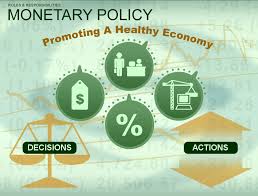“MONEY IS THE BLOOD OF AN ECONOMY”
The flow of money in an economy determines the health and future prospects of an economy and it is imperative to have stringent measures to ensure an unabated growth of the economy and its people encompassing as a whole. Lack of control over the flow of money by the concerned authorities could lead to annihilation of an entire economy.
Monetary Policy is thus introduced by monetary authority of every nation to control the supply and flow of money by altering the interest rates in order to maintain price stability and obtain economic growth thus reducing rigidity and ensuring desired and equitable distribution of credit.
The Reserve Bank of India has been successfully able to adopt monetary policy that ensures the overall wellbeing of the nation by incorporating the fluctuations of inflation, changing crude oil prices and other international affairs.
SIXTH BI MONTHLY MONETARY POLICY STATEMENTS
Based on the existing and evolving macroeconomic scenario prevalent in India, the RBI has adopted monetary and liquidity measures in the policy statement on February 2015. Some of the salient features of this policy were:
- Under the liquidity adjustment facility (LAF) the policy repo rate was left unchanged at 7.75%.
- The Cash Reserve Ratio (CRR) of scheduled banks was left unchanged at 4% of Net Demand and Time Liabilities (NDTL).
- The Statutory Liquidity Ratio (SLR) of scheduled commercial banks was reduced by 50 basis points from 22% to 21.5% of the NDTL.
- The Export Credit Refinance (ECR) facility was replaced with the provision of system level liquidity.
- Liquidity was continued to be provided under overnight repos of 0.25% of bank wise NDTL at the LAF repo rate and liquidity up to 0.5% of NDTL to be provided less than 7 day as well as 14 day term repo.
- Auction of daily variable rate term repo and reverse repo was proposed to facilitate liquidity.
- Unser the LAF the reverse repo rate remained unchanged at 6.75 % and the Marginal Standing Facility (MSF) rate as well as the bank rate continued to be 8.75%.
HIGHLIGHTS OF THE AGREEMENT ON MONETARY POLICY FRAMEWORK
An agreement on the monetary policy framework was made between the President of India and the RBI on February 20, 2015 and the salient features of this agreement were as follows:
- The RBI has set the inflation target to be below 6% by January 2016 and the target for the next fiscal would be 4% with a band of +/- 2% and necessary variations in the monetary measures would be adopted to achieve the desired target.
- The RBI has to set the Operating procedure to arrive at the desired operating targets of inflation.
- RBI also has to publish once every six months sources of inflation and forecast of inflation for six to eighteen months from the date of publication.
- If the RBI in any way fails to achieve the set target they have to submit a report to the central government stating the causes of the failure, the suggested remedies and the time required to achieve the lost target.
This agreement makes the fact explicit that both RBI and GOI have aligned objectives and the monetary policy and fiscal policy will work in complementary terms.
RECENT POLICY INITIATIVES IN CREDIT INFORMATION SHARING
Some of the recommendations of Aditya Puri Committee that are being evaluated by RBI are:
- A Common Credit Information Report (CCI) which is customized as per the existing credit information infrastructure in India.
- Reporting the desired information regarding the derivatives of clients
- Providing a base level consumer CIR on annual basis and free of cost to all the customers of credit institution by CIC.
- Mechanism that provides fast and inexpensive means for redressal of customer grievance.
Some of the benefits associated with credit information sharing are:
- Credit discipline will be maintained among consumers and will empower them to obtain loans with due consideration of their credit history.
- It will enable credit institutes to reduce credit risk and efficiently price, tag and monitor loans.
- Increased transparency in lending would reduce NPAs and create superior credit portfolios. A proper analysis of the credit information would increase lending resulting in economic growth productivity and financial inclusion.
- Some of the initiatives taken by the RBI that has extended substantial help in this realm are
- Central Repository of Information on Large Credits (CRILC)
- Central Registry of Securitisation Asset Reconstruction and Security Interest of India (CERSAI)
Some of the challenges faced by credit information sharing are:
- Poor quality of maintained data base.
- Disputes and transparency relating to consumer credit report has to be addressed.
- Bridging the asymmetry related to information regarding the credit reporting process through structured pre-credit counselling sessions.
SOME OF THE IMPLICATIONS OF MONDTARY POLICY
- The CPI was 5.1% on January 2015 when rebased to 2012 lying well within the limit of 8% thus setting in the much desired trend of disinflation at a faster pace. However in the current scenario inflation will be determined by the following:
- Rising oil prices
- Ability of the government to meet food demands.
- International commodity prices
- Exchange rates and asset prices
- Demand vs capacity of production of the economy
- The Union Budget 2015-2016 has embedded certain structural reforms to improve supply over the medium term.
- The aggregate demand will be enhanced by the postponement of fiscal consolidation by one year to the 3 percent target.
- However there are certain factors that have moderated the optimism of fiscal rectitude in the projections of the budget. These are:
- Governments desire to eradicate legacy issues.
- Large amounts being allocated to states without allocating significant funds to central programs.
THE FIRST BI MONTHLY POLICY STATEMENT OF 2015-16
This will be issued on 7th April 2015, and on the face of the weak performance of certain sectors of the economy and the global trend of easing it is imperative that policy action should be anticipatory on the ground of presence of sufficient data substantiating the policy stance.
.Click here for government certification in Accounting, Banking & Finance




